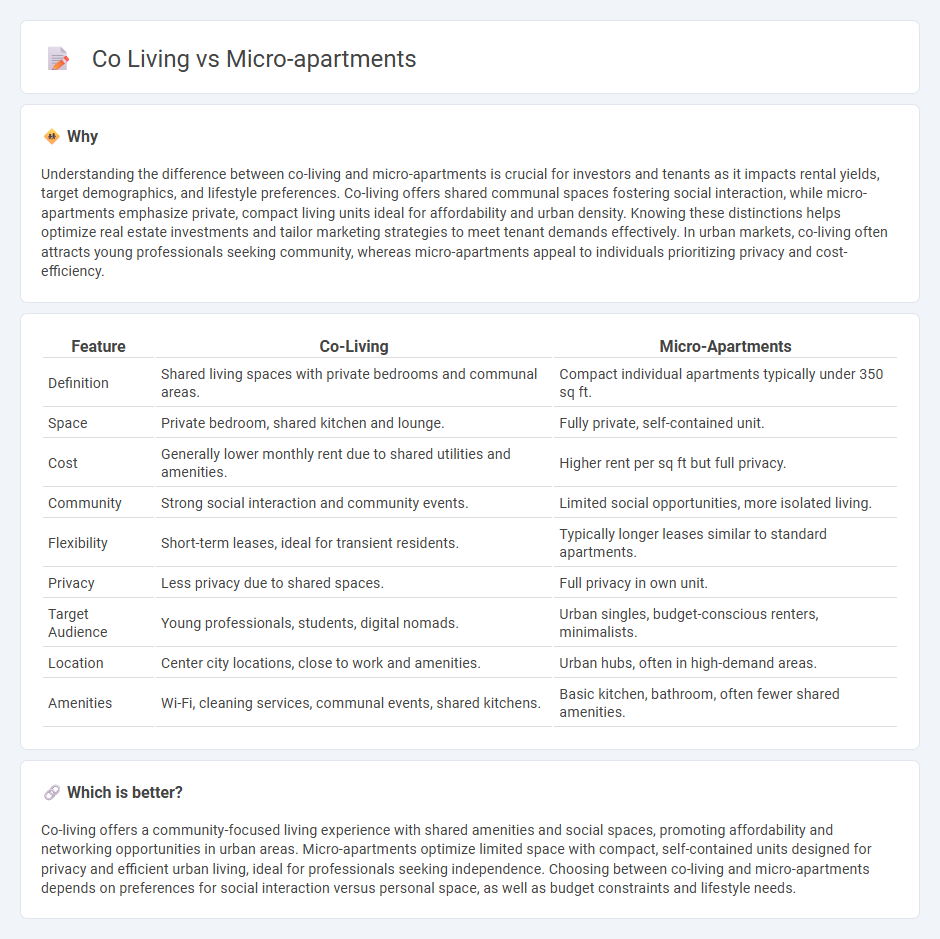
Co-living spaces offer shared amenities and community-focused living ideal for young professionals seeking affordability and social interaction. Micro-apartments provide compact, private units designed for urban dwellers prioritizing personal space within limited square footage. Explore the benefits and differences between co-living and micro-apartments to determine the best fit for your lifestyle and investment goals.
Why it is important
Understanding the difference between co-living and micro-apartments is crucial for investors and tenants as it impacts rental yields, target demographics, and lifestyle preferences. Co-living offers shared communal spaces fostering social interaction, while micro-apartments emphasize private, compact living units ideal for affordability and urban density. Knowing these distinctions helps optimize real estate investments and tailor marketing strategies to meet tenant demands effectively. In urban markets, co-living often attracts young professionals seeking community, whereas micro-apartments appeal to individuals prioritizing privacy and cost-efficiency.
Comparison Table
| Feature | Co-Living | Micro-Apartments |
|---|---|---|
| Definition | Shared living spaces with private bedrooms and communal areas. | Compact individual apartments typically under 350 sq ft. |
| Space | Private bedroom, shared kitchen and lounge. | Fully private, self-contained unit. |
| Cost | Generally lower monthly rent due to shared utilities and amenities. | Higher rent per sq ft but full privacy. |
| Community | Strong social interaction and community events. | Limited social opportunities, more isolated living. |
| Flexibility | Short-term leases, ideal for transient residents. | Typically longer leases similar to standard apartments. |
| Privacy | Less privacy due to shared spaces. | Full privacy in own unit. |
| Target Audience | Young professionals, students, digital nomads. | Urban singles, budget-conscious renters, minimalists. |
| Location | Center city locations, close to work and amenities. | Urban hubs, often in high-demand areas. |
| Amenities | Wi-Fi, cleaning services, communal events, shared kitchens. | Basic kitchen, bathroom, often fewer shared amenities. |
Which is better?
Co-living offers a community-focused living experience with shared amenities and social spaces, promoting affordability and networking opportunities in urban areas. Micro-apartments optimize limited space with compact, self-contained units designed for privacy and efficient urban living, ideal for professionals seeking independence. Choosing between co-living and micro-apartments depends on preferences for social interaction versus personal space, as well as budget constraints and lifestyle needs.
Connection
Co-living and micro-apartments are interconnected as innovative housing solutions addressing urban space scarcity and affordability challenges. Co-living offers shared communal areas within micro-apartment complexes, maximizing efficient use of limited square footage while fostering community engagement. This synergy supports sustainable urban living trends by combining privacy in compact private units with collaborative social environments.
Key Terms
Space Efficiency
Micro-apartments maximize space efficiency by offering compact, multifunctional living areas typically ranging from 200 to 400 square feet, ideal for urban dwellers seeking privacy and affordability. Co-living spaces optimize communal living with shared kitchens, lounges, and work areas, balancing private bedrooms of about 100 to 150 square feet with expansive common areas to enhance social interaction and resource sharing. Explore further to discover which option best suits your lifestyle and space needs.
Shared Amenities
Micro-apartments typically offer private living spaces with limited shared amenities such as laundry facilities or small fitness areas, focusing on maximizing individual privacy in compact units. Co-living spaces emphasize extensive shared amenities, including communal kitchens, lounges, coworking spaces, and social events designed to foster community interaction and collaboration among residents. Explore further to understand how shared amenities impact lifestyle and cost-effectiveness in micro-apartments versus co-living arrangements.
Privacy
Micro-apartments offer individual living spaces with complete privacy, featuring private bathrooms and kitchens designed for solitary use. Co-living spaces emphasize shared common areas such as kitchens and lounges while providing private bedrooms, which can limit personal privacy but foster community interaction. Explore the balance between privacy and social engagement in micro-apartments and co-living arrangements to find the best fit for your lifestyle.
Source and External Links
Microapartment - Microapartments are compact, self-contained living spaces that typically include a sitting area, sleeping space, bathroom, and kitchenette, maximizing space and affordability in urban areas.
Tiny apartments a big deal in many US cities - Micro-apartments are increasingly popular in U.S. cities like Seattle, Boston, and Newark, driven by zoning reforms aiming to increase affordability and housing density.
Nest Micro Apartments - Nest Micro Apartments offer affordable, furnished living spaces near NYC, designed for young professionals seeking community and convenience.
 dowidth.com
dowidth.com